
HOW TO INSTALL CROWN MOULDING
1. Preparation
1. Take measurements to get the linear footage needed to span the distance to be
trimmed out. Add 10 percent to this figure for waste and mistakes.
2. Select the style and finish you want for your new crown molding. There are many
shapes and sizes available.
3. Pick a style that suits your decor and personal taste. The finish that you put on should
be purchased and applied before you start any cutting and fitting.
4. Try to buy your trim in lengths that will need as few splices as possible. In some cases
splices are unavoidable but the fewer there are the better the finished job will look.
(Very long walls may have to be spliced ― 14 to 16 feet is about the longest you will
find in most trim pieces and these longer pieces are more susceptible to warping and
damage.)
5. Stain or paint all the molding then allow it to dry thoroughly.
6. Doing trim work is easier and more accurate with a comfortable place to work. This
should consist of a long bench set up at a comfortable height. Note: This can be as
simple as several long 2-by-4s laid out on top of saw horses. This will hold your miter
saw (electric or manual) and support the trim as you work on it.
7. Cutting the needed angles for the corners of your trim is handled most accurately with a
miter saw.
8. Set your work station where there power readily accessible and plenty of light.
9. Working over your head is tiring and awkward; a solid working platform makes the work
much safer and easier. Use a heavy plank and two sturdy sawhorses or rent scaffolding
on wheels to use as a platform to stand on while installing the molding.
2. Trimming and Joining
1. Overcome not-quite-square corners ― and most of them are not square ― with a
"coped" joint:
2. Run the first piece of crown molding tightly into the corner. Cope-cut the second piece
that will form the other leg of the corner angle in the shape of the profile of the molding
so that it can butt neatly against the face of the first piece. Here's how:
3. Use a deep miter box and a fine-toothed saw to make a cut that reveals the profile of
the molding. Position the molding so that it is upside down in the miter box. The face of
the molding that goes against the ceiling will be on the bottom of the miter box.
Remember, for inside corners, the bottom of the crown molding will be the longest edge.

4. Cutting the proper miter will reveal the profile of the molding. Cut away the excess wood
along the backside of the molding following that profile line with a coping saw. Err on the
side of removing too much rather than too little; only the outermost edge of the coped
molding will be seen.
5. Use a utility knife to remove any excess material you missed with the coping saw. Be
careful that you do not cut into the exposed face of the molding. Hold the piece in place
to test the fit. Take it down and do more carving if necessary. This will sometimes take
several fittings and trimmings to get the cleanest-fitting joint.
6. Planning out the job will help save work and material. Work out a pattern in which one
end of each piece of crown molding will always be cut straight and one end will be
mitered and or coped. Use scarf joints for long runs (where the pieces meet, cut the
ends at 45 degrees so they will overlap). Layout the work so joins are on top of studs.
Save the most visible parts of the job for last, when you've honed your coping skills.
3. Attach and Finish
1. Determine the location of the joists. Drill pilot holes to keep the molding from splitting.
2. Attach the molding with only a few nails. (Use 6d or 8d finish nails for this, depending on
the thickness of the molding). Take a good look at the positioning before completing the
nailing.
3. Provide a solid nailing area where the joists run parallel to the crown molding by using a
2 x 2 cut on a 45-degree bevel. Cut the 2-by-2 to length then screw it to the wall so that
it's in the corner where the ceiling and wall meet. The 2-by-2 provides a solid surface
sitting at an angle, to which you can nail the molding.
4. Countersink all nails using a nail set.
5. Use wood putty to fill all visible nail holes help cover any small gaps at the joints to give
things a more seamless appearance. Wait for the putty to dry and sand it smooth with
fine sand paper.
6. Finish the nail holes and small fill-ins to match the rest of the molding, and enjoy your
new look.
-
 1
1
-
 2
2
Unbranded CAL860PPR Installation guide
- Type
- Installation guide
Ask a question and I''ll find the answer in the document
Finding information in a document is now easier with AI
Related papers
Other documents
-
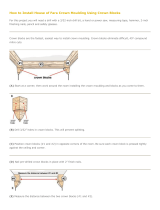 House of Fara 59008 Installation guide
House of Fara 59008 Installation guide
-
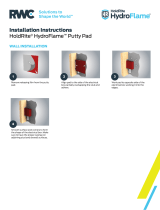 Holdrite HF-PP-2 Installation guide
Holdrite HF-PP-2 Installation guide
-
 AMERICAN TIN CEILINGS kit-n-p06-wbg Operating instructions
AMERICAN TIN CEILINGS kit-n-p06-wbg Operating instructions
-
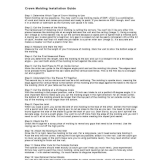 Fine Art Deco CMF-038 Installation guide
Fine Art Deco CMF-038 Installation guide
-
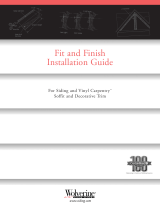 Wolverine Soffit and Decorative Trim User manual
Wolverine Soffit and Decorative Trim User manual
-
Armstrong Ceilings 5424204NAR Installation guide
-
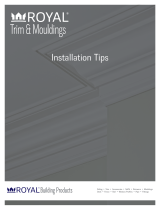 Royal Mouldings RY308-ZM144CRY Installation guide
Royal Mouldings RY308-ZM144CRY Installation guide
-
Craftsman CTS205 User manual
-
 Inteplast Group Building Products 98880700032 Installation guide
Inteplast Group Building Products 98880700032 Installation guide









